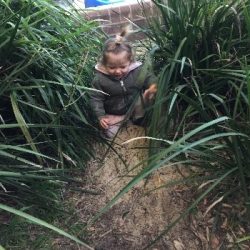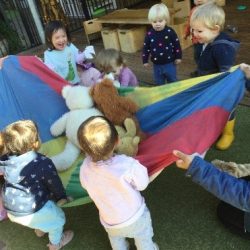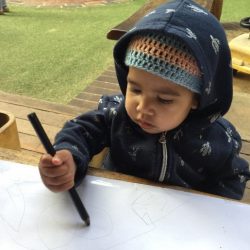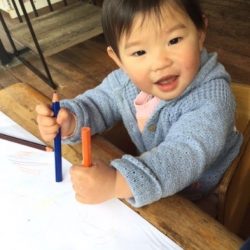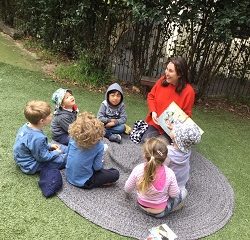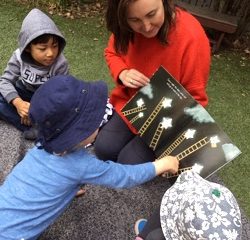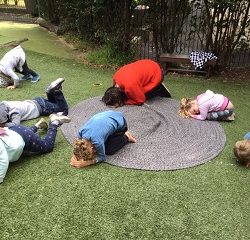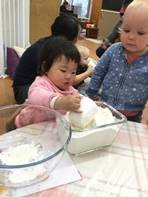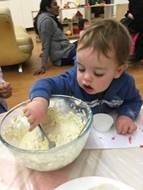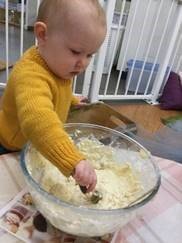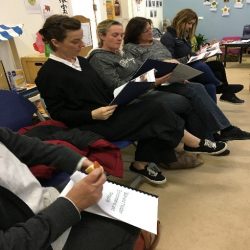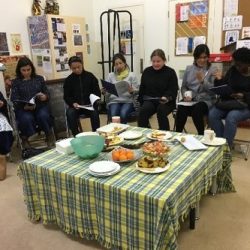Gorton House
Some snippets from the last few weeks in the Infants’ Room news
The children have taken to spontaneously spending extended time in the garden. It’s quite routine now for us to have a teddy bears’ picnic happening on a mat, to spot a small group going for a bear hunt, or to hear the rhyme ‘Walking through the jungle, what do I see’ ringing out during our play. One of the purposes of the structure of our outdoor space is to provide time and opportunities for extended play and exploration, individually and in small groups, as well as the option to return to play and expand on ideas through self-directed play, associative and co-operative play with peers, and intentional teaching and experiences with educators and peers. It is also a good space in which to offer children something of the perspectives of Indigenous Australians, and the land’s traditional owners—the Wangal Clan, of the Gadigal People of the Eora Nation.
Bears have also been taking over other times and places in our play. They have been popular choices for imaginative and pretend play, as the children explore their world, through practice and play at activities and experiences which we are involved in every day, such as mealtimes, sleeping, soothing. Using our scarves as blankets, wraps and covers has been so much fun! Bears have also made an appearance in our games, music and movement times, including when we had such fun bouncing them on the trampoline, made out of our parachute. We had to work together for it to work properly, but when it did, it was really great!
We have also been getting very happily creative lately too, with plenty of mark making, and making our first steps into easel painting, which has been really fantastic. We will continue these explorations using different media, colour and spaces to investigate our self-expression, and build our own ideas and creative processes.
Johnson House
The children in Johnson House preschool have been reading The Lost Stars by Hannah Cumming. The story is about how everyone has become so focused on bright lights and new technology that they have forgotten about the stars. Fed up with not being appreciated, the stars decide to leave their posts and go on holiday. We recapped the story to aid children’s understanding using ‘first’, ‘next’, ‘then’ and ‘last’. We also explored the feelings of the stars, the fast paced lives that people live and the smog in the sky that stops us from seeing the stars. We tried to understand how the stars might feel if no one is looking up at them anymore. We pulled facial expressions to show fed up and noticed how the facial expressions of the stars changed from being happy to go to work in the sky to feeling fed up when they weren’t noticed.
The Lost Stars also presented a great opportunity for us to explore opposites with the children, for example, dark and light. We also learnt a new song to help us to keep thinking about opposites. It was about fast and slow. First we acted it out with our hands and then our bodies as we pretended to be bunnies and turtles. The children really enjoyed expressing their understanding of language concepts through play, and we will continue to explore this book in coming weeks.
Murray House
Infants
For months the infants in Murray House have been exploring pretend play, especially ‘making cupcakes’. This interest is observed in many learning spaces, such as the sand pit, playdough table, and the art room. Educator Rosie followed this interest and invited the children to expand their idea by providing them with art and craft materials, such as coloured paper, scissors and glue for them to decorate their ‘cupcakes’. The children also used their senses and practiced their fine motor skills by rolling play dough and moulding it into cake shapes; the song Five Little Currant Buns was introduced to link this interest with early mathematical skills, such as one to one correspondence.
This week, the children were invited to participate in a cooking experience, making real cupcakes! They worked in collaboration to stir and mix the ingredients, taking turns to pour the batter into cupcake pan, and waited patiently for them to bake and enjoy the end result!
Toddlers
To reinforce the idea that things can be renewed via recycling, educator Murray House toddlers Denise introduced a new material for sensory play and artistic creation—paper pulp. At first the children were a bit hesitant about the odd weight and texture of the paper pulp. However, their strong sense of curiosity soon broke through and the children were enthusiastic to get started, and their sensory play was mostly investigative in nature. Throughout August, the children have had opportunities to join in repeated experiences to build their investigative and experimentation skills, as well as their familiarity in manipulating the paper pulp to create.
Robinson House
Integrated group with Justine at Robinson House
The children are becoming very familiar with the story Mr McGee by Pamela Allen. After reading the story, we spent time discussing what happened, and recalling the sequence of events using some visuals. Sequencing is the skill that we use when we break down an event into simple steps and put those steps in order. We need sequencing skills to understand how to perform certain tasks that require the steps be done in a specific order. Apart from its comprehension benefits, sequencing is also a pre-literacy skill. Being familiar with sequencing language such as (first, then, next, last) is needed to support phonological awareness when breaking up and sequence sounds in preparation for spelling and reading at school. At every group, prior to starting any fine motor activities, we perform some exercises specifically to develop finger-to-thumb opposition and open the web space in the hands. Having strong finger opposition and being able to maintain an open web space are both incredibly important fine motor skills. Both skills heavily influence grasp, as well as the effective and efficient use of tools.
After listening to Mr McGee, we used some lacing cards that were pictures from the story. Lacing cards are particularly great for the following: Pincer Grasp Development (making the string move in different directions using a ‘pad-to-pad’ grip, which is a fine motor skill children require for performing many tasks), bilateral coordination (using their dominant hand as the tool controller and the non-dominant one as the assistant), hand-eye coordination (the use of information seen through the eyes to coordinate and control the hands) and motor planning (an integration of the brain and senses to first generate an idea of what you want to do, then figuring out how you are going to do it, and then executing it).
We also practiced cutting again. Having effective scissor skills is important for the development of all of the small muscles in the hand—these muscles are also used for writing, painting, and gripping things like a toothbrush, spoon or fork, and even pulling up pants. Cutting also enhances eye-hand coordination (using vision, processing what is seen, and moving the hand simultaneously to accomplish a task), and encourages the use of bilateral coordination (using both sides of the body at the same time while each hand is performing its own task).
Family Day Care Sydney Wide
Last week Janîce Francis, Children’s Services Manager of Family Day Care, facilitated a training session for educators in our Randwick Hub. 16 registered educators from our scheme came together to participate in an evening to increase their knowledge and skills for the care and education of babies and toddlers.
These educators are committed to ongoing professional development. The session was called ‘Baby and Toddler Environments and Pedagogy”, an area that can at times be challenging in relation to planning and programming, and one which is a requirement of an educator’s role.
All educators are unique in the delivery of their service, and they are happy to embrace new ideas. Training sessions such as this also provide them with the opportunity to share their many years of hands-on experience, and what’s happing in their service.
Forums and training sessions are offered on a monthly basis throughout the year, and these cover a range of topics of interest. This year we still have literacy training in September and inclusion training November, as well as supper evenings where we view educators’ services, to look forward to.
In last week’s babies and toddlers session the educators were provided with a very useful resource filled with photos of inspiring learning spaces and suggestions for taking steps to make changes in their own services. We have had very positive feedback about the session.
